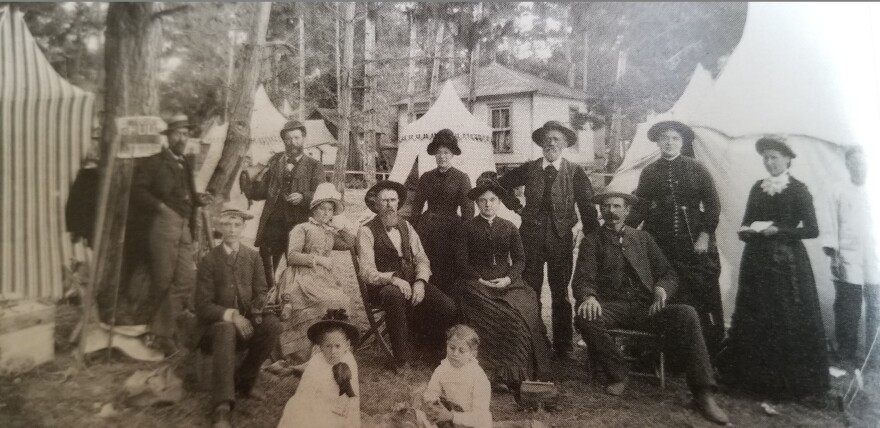A mover carefully hoisted a large box packed with plastic covered photographic prints from Pat Hathaway’s living room, reading off the label with an air of excitement, “Big Sur photos from the 1800’s.” Another tightly packed box was marked, “Cannery Row - John Steinbeck - Ed Ricketts.”

What Hathaway left behind after his unexpected death last year is staggering in both its size and import. The Pacific Grove photographer dedicated his life to amassing the photographic and visual history of early California, especially the Monterey area. His business was called California Views, which he used to sell prints online and license rare photos to third parties.
It took a team of professional movers two days to complete the delicate transfer. The collection includes more than 80,000 original photographs and negatives, some dating back to the California Gold Rush during the late 1840s and 50s.

Hathaway’s “digital” and computer scanned documents are estimated to comprise an additional 500,000 images, many of them rare artifacts scanned from the archives of other collectors.
“It is without hesitation the finest collection of its kind for this region on the entire west coast,” said James Perry, executive director of the Monterey County Historical Society.

Following a decision in probate court in late December, the historical society, with a warehouse and future museum in Salinas, became the new owner of the Hathaway archives. Perry says his mandate is to make the collection “publicly accessible.”
Most of it relates directly to the cities and towns that sprung up along Monterey Bay during the late 19th and early 20th centuries. The photos show how people lived along Monterey Bay 175 years ago - how industries evolved, like fishing and farming.

Hathaway, who died in January 2021 at the age of 72, left no will, was never married, and had no children. So, his estate landed in the Monterey County Superior Court probate department. Local historian Kent Seavey was assigned the role of executor to protect the archives until the court decided where they should go.
Seavey described Hathaway’s work as, “a lost history of Monterey County… that means Santa Cruz, Monterey, the Big Sur, Salinas Valley, all of the above.”
Seavey, who authored several books on the architecture and history of the Monterey region, said Hathaway was the source of hundreds of rare photos that appear in the popular local history series published by Arcadia. He said a number of those books depicting our regional history would not exist without Hathaway’s help.

Seavey authored the edition on Pacific Grove, where Hathaway lived, and where the community began as a tent camp, a religious and educational retreat for methodists. Hathaway’s 135-year-old photos, Seavey explained, show the reader what it actually looked like.

“Before the photograph,” Seavey said, “you had verbal descriptions of things that occurred. The photograph put you in it. “
Hathaway’s friends include maritime historian Tim Thomas who gives walking tours of old Monterey. Thomas often shows Hathaway photos to bring history alive. He said Hathaway was their “go to” guy for lost photos, like the one of a 1940s restaurant at Bixby Bridge. Only Hathaway had it.

“I used to go see him all the time and I (would) ask him for a particular photograph and usually he could find what we're looking for,” Thomas said.
One of Hathaway’s closest friends was Steve Travaille, an avid collector at the Cannery Row Antique Mall. Travaille said they collaborated, sharing documents and photographs for Hathaway’s archives, until he died.
He said their friendship spanned almost fifty years. When Travaille was selling homes in Carmel back in the 70s, he said Hathaway would provide the background history on the homes.

“I'd list a house and the next day I'd come back and the owners of the house would be just dumbfounded that I had a picture of Jack London standing in front of it in 1910.
More than a collector, Travaille said Hathaway was a curator, scanning and documenting the treasures of other collectors.
“It's (about) making it a resource,” Travaille said. “That was his passion.“
James Perry with the Monterey Historical Society emphasizes how multidimensional the Hathaway collection is. Not only does it document the way everyday life and work evolved over a span of 175 years, it has the physical evidence to show how photography developed.

Dating from the 1840s, the collection includes thousands of images from box cameras, which was how early photographers captured images on a variety of polished metal plates.
“Back to the original tin types,” said Perry. “That transitions into the glass plate negatives, (which) transitions to the hand-colored photographs, the black and white photos, sepia tone, and finally into color.”
With the historical society’s recent acquisition of the collection, it is now up to Perry, who was inspired by Hathaway as a young boy, to make the photo historian’s lifetime of work available to the public.
Perry said over his five decades of building the archives, Hathaway fully documented a quarter of the inventory. Which means there may be as many as 60,000 visual artifacts yet to be reviewed.

The Hathaway collection is now safely moved inside one of the historical society’s large humidity and fire controlled vaults. But it won’t be forgotten, Perry promises.
“There's absolutely no excuse whatsoever for collections like this to remain in vaults unappreciated.”
The archives will become a public resource. Perry said Hathaway taught him years ago “to preserve memories, to preserve the past.”
So when will the public be able to see the collection?
Perry warns, “be patient.” The Monterey County Historical Society will be working with the California State Library, and he said it will take at least six months to get the website properly cataloged. Meanwhile, Hathaway’s website, California Views, is still active and packed with visual evidence of our fascinating history.



